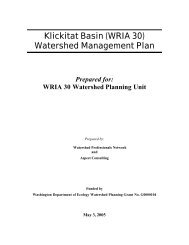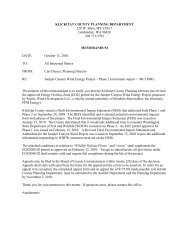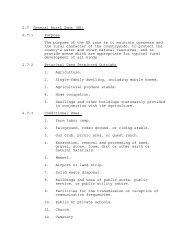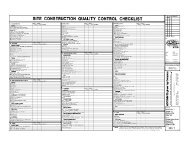WRIA 31 Instream Habitat Assessment
WRIA 31 Instream Habitat Assessment - Klickitat County Home
WRIA 31 Instream Habitat Assessment - Klickitat County Home
Create successful ePaper yourself
Turn your PDF publications into a flip-book with our unique Google optimized e-Paper software.
Table 11. Total estimated volume of pools (m 3 ) by basin and stream.BASIN / STREAMTOTALChapman Creek 17Glade Creek 554Pine Creek 182Rock Creek Luna Gulch 111Quartz Creek 76Rock Creek Mainstem 2,982Squaw Creek 1,060Rock Creek Total 4,229Wood Gulch 426Grand Total 5,4084.1.2 Spawning Area and Substrate ConditionThe area of spawning habitat was estimated for each channel unit containing spawninghabitat (including riffles, glides, and the tails out of many pools), and the averagespawning area per 100 meters was estimated for each segment. The mean and standarddeviation of spawning area was calculated for the portions of each reach that wereincluded in the study by averaging the values for each segment and completing thecalculations for standard deviation (Zar 1974). Spawning area per 100 meters rangedfrom 0.0 to <strong>31</strong>4.5 m 2 per 100m and averaged 77.7 m 2 per 100m (Table 12; Appendix A,Maps 17 through 24). Expanding the average spawning area per m 2 over the total lengthof each reach, including portions not directly sampled, the total estimated area ofspawning habitat in the study area is estimated at 5,408 m 2 , 78 percent of which is locatedin the Rock Creek basin (Tables 12 and 13).The substrate composition was documented for each channel unit in each sample segment(Table 14). Two methods were used to document substrate condition. The modifiedWentworth procedure visually estimates the percent of the substrate that falls into a rangeof categories. This measure is focused on the composition of the materials within thesubstrate. In addition, a visual estimate of embeddedness was documented. Thismeasure focuses on the amount of fine sediment overlying the substrate.In general, substrate materials tended to be slightly coarser in riffles than in other channelunit types (pools, glides, marshes) (Figure 9). Chapman Creek and Glade Creek basinstended to have a much higher percentage of fines than were observed in Rock Creek,Wood Gulch, and Pine Creek. As will be discussed later, this is related to the underlyinggeology of the basins. Glade and Chapman Creek have much less spawning material(gravel/cobble) than is found in the other basins.<strong>WRIA</strong> <strong>31</strong> <strong>Instream</strong> <strong>Habitat</strong> <strong>Assessment</strong> 27 Watershed Professionals Network









